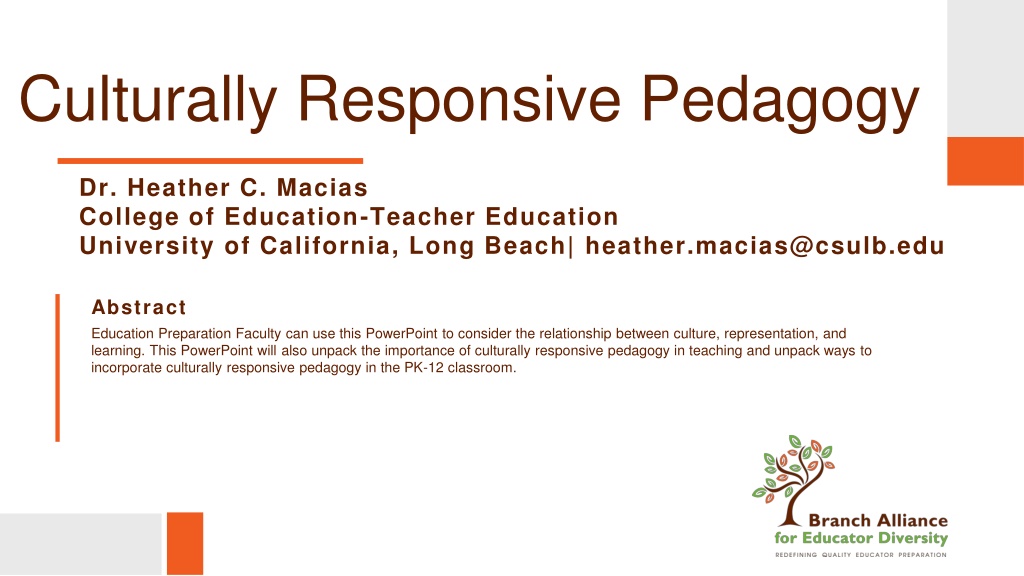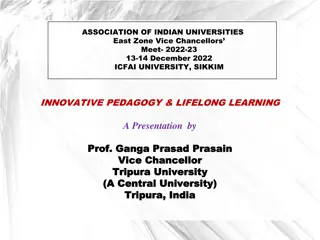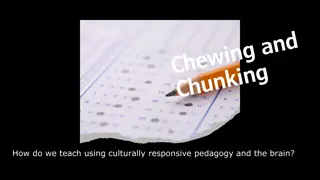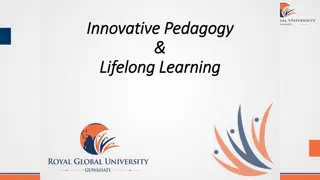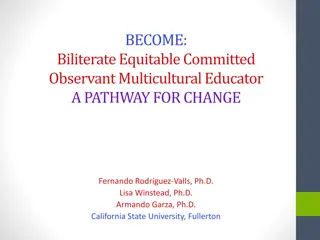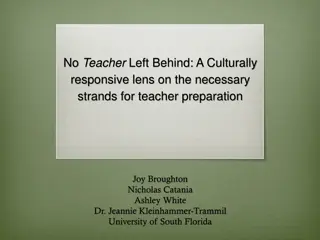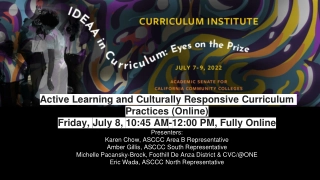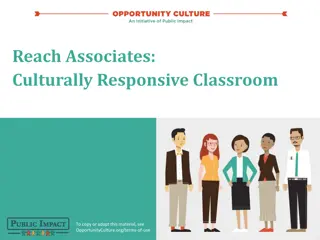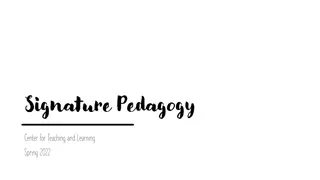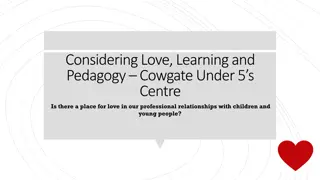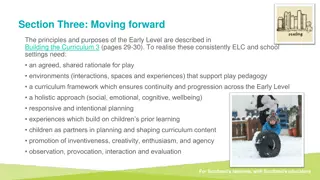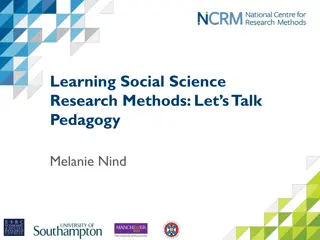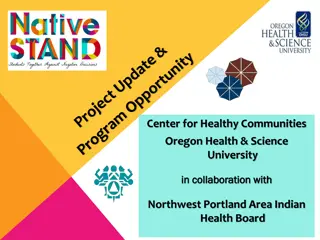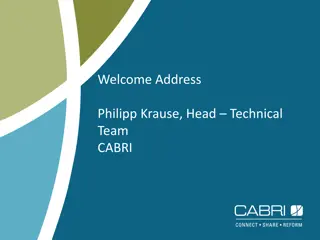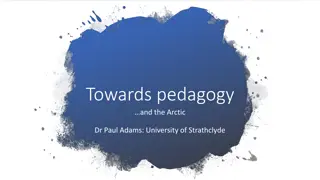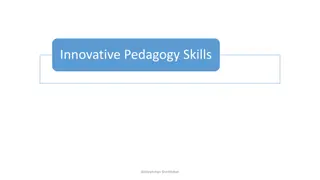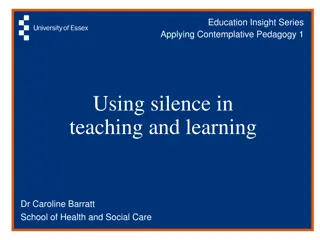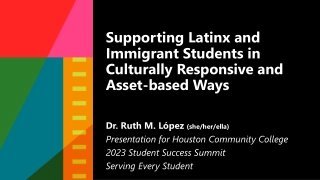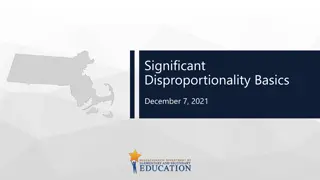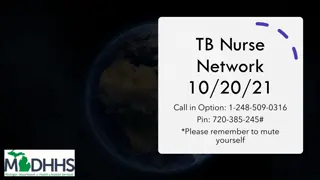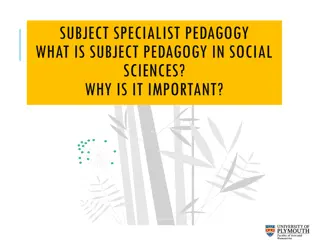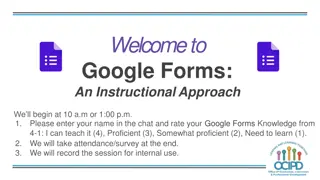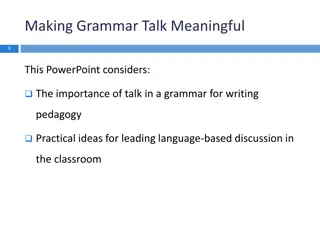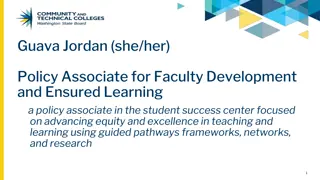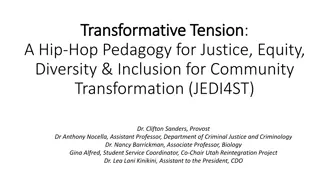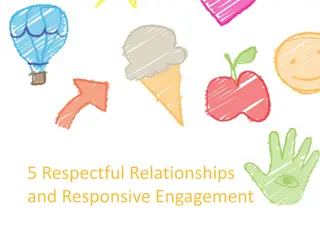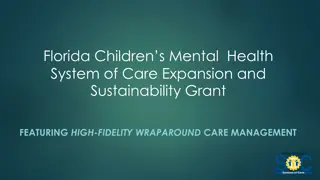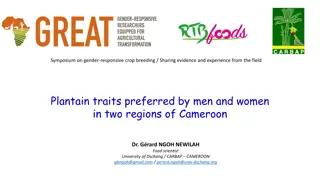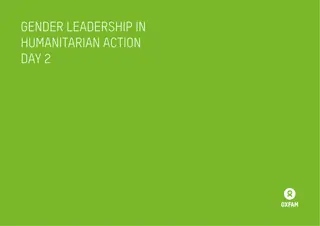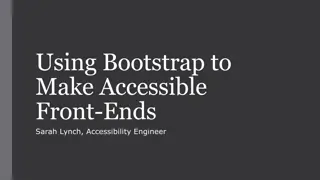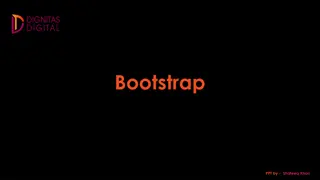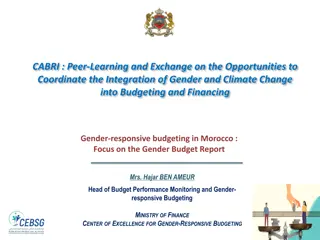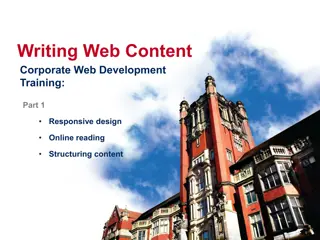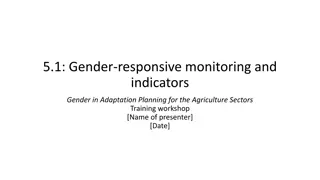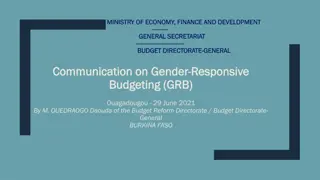Exploring Culturally Responsive Pedagogy in Education
This presentation by Dr. Heather C. Macias delves into the significance of culturally responsive pedagogy (CRP) in education. It discusses the relationship between culture, representation, and learning, emphasizing the importance of incorporating CRP in teaching practices to create equitable and accessible K-12 classrooms.
Download Presentation

Please find below an Image/Link to download the presentation.
The content on the website is provided AS IS for your information and personal use only. It may not be sold, licensed, or shared on other websites without obtaining consent from the author. Download presentation by click this link. If you encounter any issues during the download, it is possible that the publisher has removed the file from their server.
E N D
Presentation Transcript
Culturally Responsive Pedagogy Dr. Heather C. Macias College of Education-Teacher Education University of California, Long Beach| heather.macias@csulb.edu Abstract Education Preparation Faculty can use this PowerPoint to consider the relationship between culture, representation, and learning. This PowerPoint will also unpack the importance of culturally responsive pedagogy in teaching and unpack ways to incorporate culturally responsive pedagogy in the PK-12 classroom.
Culturally Responsive Pedagogy: A Primer Dr. Heather C. Macias College of Education - Teacher Education California State University, Long Beach
Learning Objectives Learning Objective(s): By the end of this lesson, we will have . Considered the relationship between culture, representation, and learning. Unpacked the foci and importance of CRP in teaching. Unpacked ways to incorporate CRP into K-12 classroom teaching.
Learning Agenda Agenda: Culture, Representation, and Learning The Issue(s) Culturally Responsive Education Ladson-Billings (1995) 3 CRP Tenetsay s (2018) 8 CRP Principles A Special Note on CRP in STEM Suggestions for Incorporating CRP into Teaching Menu of CRP Strategies Reference List
Culture, Representation, and Learning Questions to consider when thinking about the connections between culture, representation, and learning: In your education, did you regularly see people who looked like you or people you could identify with in the curriculum you were taught? K-12? Undergraduate education? In your education, was the language spoken at home also spoken as a language/dialect of your school? K-12? Undergraduate education? What might be the impact on your students if the answer to all the above questions was no ? No, I have never learned about or been taught by someone who looked like me. No, I have never heard my language from home spoken in a school setting.
The Issue(s) The educational achievement or opportunity/equity gap (Carter & Welner, 2013) The Eurocentric history and tradition of US education fails to acknowledge the contributions and complexities of culture and historically marginalized groups knowledge, narratives, and histories across disciplines (McKinley et al., 2008) What is needed to make K-12 education more equitable and accessible for ALL? Instructors who have the knowledge and skills to teach in ways that recognize students diverse backgrounds and build on students/families/communities cultural/linguistic knowledge, skills, and strengths (Howard, 2019; Sleeter, 2001) Curricula that is meaningful and equitable (Welner & Carter, 2013) Without implementing these steps... Culturally diverse students will continually be unable to reach their full potential Perpetuation of the opportunity/equity gap Lack of diversity in many majors and departments in higher education and the fields as a whole (e.g., STEM fields)
The Solution: Cultural Competence Cultural competence is really about how does one take inventory or begin to develop a capacity to understand the diverse and wide range of ways in which students and individuals make meaning of the world that they are in how they make meaning out of school, how they problem solve, how they question, how they interpret particular events, how they begin to dig for a certain kind of understanding when it s not always readily available, the dynamics of family and the role that family plays in different households, the importance of different historical events and what it means for different individuals in different groups. (Howard, as qtd. in Clark et al., 2016, p.269)
Culturally Responsive (CR) Education Different scholars and frameworks to bring cultural awareness into the classroom, each with different foci. (Kotluk & Kocakaya, 2018)
Culture, Representation, and Learning ACTIVITY: Think about a group identity (i.e., Latinx, hard of hearing, Islamic, women) whose identity may be underrepresented in your discipline (i.e., Math, P.E., Music, Social Studies). On your computer, enter a group representation in discipline in a Google search for possible sources of representation. Example: LGBTQ+ representation in science What patterns or themes do you notice across the search results? What general conclusions about representation in your discipline can you possibly derive from this Google search? What general conclusions about particular students in your classroom can you possibly derive from this Google search?
Why Culturally Responsive Education? To learn at their best, students must be engaged and motivated (Mendoza, 2013) These are not fixed feelings in students and can change! Students who feel both valued by adults and included in their schools perform better academically, and have more positive social attitudes, values, and behavior (Collaborative for Academic, Social and Emotional Learning, 2008) If a teacher understands the whole student (identity, culture, community, etc.), students will be more invested and self-motivated to learn (Fernandez, 2018)
A More Specific Solution: Culturally Responsive Pedagogy (CRP) Ladson-Billings (1994, 1995, 2006, 2009, 2012): A pedagogy that empowers students intellectually, socially, emotionally, and politically by using cultural referents to impart knowledge, skills, and attitudes ...questioning (and preparing students to question) the structural inequality, the racism, and the injustice that exist in society Normalize students of color, while teaching in a way that meets the needs of all students Gay (2002, 2010, 2018): Using the cultural characteristics, experiences, and perspectives of ethnically diverse students as conduits for teaching them more effectively Transition teaching from a classroom- centered perspective to instruction that includes beyond-the-classroom factors (i.e., students at-home experiences) Ethnic ways of knowing and core identities are valued alongside dominant canons of knowledge
Ladson-Billings approach to CRP Three Tenets of CRP: 1. Sociopolitical Consciousness 2. Cultural Competence 3. Academic Achievement
3 CRP Tenets (Ladson-Billings, 1995) #1 - Sociopolitical Consciousness The ability to critique cultural norms, values, mores, and institutions that produce and maintain social inequities Teachers must: Be engaged critically with their students, school, community, and larger locales - get to know your students and their community Be willing to bring multiple historical and contemporary perspectives into the classroom and not be afraid to identify political underpinnings in texts, the communities, or social worlds of students - bring criticality into your curriculum Assist their students in developing critical consciousness by encouraging and assisting them with a variety of social action projects - connect the curriculum to local community issues/topics
3 CRP Tenets (Ladson-Billings, 1995) #2 - Cultural Competence Affirming students cultural identities, facilitating the process of students forming a positive cultural identity and maintaining cultural integrity, and using students cultural knowledge in the classroom - connect students prior and cultural knowledge/skills to new knowledge/skills Students achieve academically with their cultural identities intact - students don t need to erase their culture to learn or fit in at school Teachers: Utilize students culture as a medium for learning and positions students knowledge and lived experience as valuable and foundational for developing new knowledge - students are encouraged to use their cultural knowledge/skills as tools for learning and teaching others Increase the cultural competence of their students by honing in on cultural aspects that are important to students - bring students identities and cultures into the curriculum
3 CRP Tenets (Ladson-Billings, 1995) #3 - Academic Achievement Support students development of academic skills, hold high expectations, and attend to students learning needs by inspiring students to empower themselves for excellence, not just making them feel good - encourage students to learn from one another, ask critical questions, self-monitor their learning Academic success entails achievement in reading, writing, speaking, computing, and posing and solving problems that extend beyond traditional assessments - project-based learning, authentic contexts, community engagement as assessment are motivating and relevant to students lived experiences Academic success includes the development of social and political skills to actively participate in a democratic society - encourage students to ask the difficult questions, including what isn t be taught and why Helping students achieve academic success is a primary responsibility!
3 CRP Tenets On the next slide, review the CRP tenets and indicators. Then consider the following questions: What distinguishes these tenets from traditional teaching approaches? Where do you see overlap between the 3 tenets? Which tenet(s) do you find the most impactful/important for K-12 students?
Gays approach to CRP Eight Principles of CRP: 1. Validating and Affirming 2. Comprehensive and Inclusive 3. Multidimensional 4. Empowering 5. Transformative 6. Emancipatory 7. Humanistic 8. Normative and Ethical
8 CRP Principles (Gay, 2018) #1 - Validating and Affirming Utilize different learning strategies Individual, pair, and small group work are all used regularly Incorporates multiple modes of expression (music, translanguaging, teachers stories about life experiences) Create connections between students realities, home lives, and cultures, and the curriculum An assets-based perspective of students and their families, viewing them as resources for learning Lessons helps students to know and praise their own and other students cultural heritage Regularly incorporate multicultural resources, information, and materials in all subject areas
8 CRP Principles (Gay, 2018) #2 - Comprehensive & Inclusive School builds a culture of community or family Teachers are knowledgeable about and/or engaged with the history and culture of the local community Students are taught to be responsible community members - schools don t exist in a vacuum, but are part of the local community Learning is a communal and reciprocal and manifested in their behavior - peer teaching #3 - Multidimensional Students are given opportunities to share their emotions, beliefs, values, ethos, opinions, and feelings alongside factual information to make curriculum and instruction more responsive to ethnic diversity - ask students for their opinions, thoughts, ideas about what they re learning
8 CRP Principles (Gay, 2018) #4 - Empowering Opportunities for social scaffolding are included Examples: peer teaching, students learn the cultural capital of schools (study skills, test taking strategies, presentation skills), peer mentoring Differentiation in content, knowledge production, and in learning environments #5 - Transformative Teachers recognize the skills that students from different backgrounds bring into the classroom (presentation styles, learning styles, group dynamics) and use/enhance them through diverse classroom instructional practices Academic success and cultural competence are not pitted against one another, but developed in unison through the curriculum - connect culture to content Students develop a social consciousness to combat racism, prejudices, and other forms of oppression and exploitation - develop students criticality Curriculum is challenging and even critical, rather than solely skills-based
8 CRP Principles (Gay, 2018) #6 - Emancipatory Students learn that there are multiple truths, realities, counter narratives, and perspectives - include the voices of historically marginalized groups in your content Students are encouraged to find their own voices to critique the world around them and to respond to social justice issues around them - encourage students to ask questions, share their opinions, critique ideas they re learning about #7 - Humanistic Curriculum values majority and non-majority students to acquire deeper and more accurate knowledge about cultures, lives, experiences, and accomplishments of diverse peoples - diversify content to include the knowledge/skills of historically marginalized groups Students are taught to be open, receptive, and respectful of others, including a willingness to critique and learn from others - create opportunities for students to share structured feedback with one another Students learn to promote equity and social justice - connect relevant, local issues to content/assessment
8 CRP Principles (Gay, 2018) #8 - Normative and Ethical Teachers are aware of the explicit ways in which mainstream educational policies and practices have been shaped and reflect Eurocentric culture, perspectives, and experiences of those in positions of power and privilege - self-reflection is key Teachers are aware of the connections between culture and education and realize it is right and ethical to incorporate cultural diversity into education - value and normalize the presence, knowledge, skills of historically marginalized groups as part of classroom learning (not just for token holidays!)
8 CRP Principles + Teaching Strategies (Gay, 2018) Examine this graphic organizer containing Gay s eight principles of CRP and some of the strategies that instructors can use to embody each principle in their teaching. Questions to consider: Which of these strategies have you seen used by the teachers in your classroom observations? Which of Gay s principles do you think is the most impactful/important for K-12 students to experience in the classroom?
What Does it Mean to be a Culturally Responsive Educator? In sum, culturally responsive educators... Are socioculturally aware (Ladson-Billings, 1995) - get to know your students/school/community Validate students backgrounds (Gay, 2010) - connect students identities/cultures to their classroom learning Expand perceptions of their content as it is currently taught in schools (Gay, 2010) - diversify your content Build communities of learners (Ladson-BIllings, 1995) Reflect on their teaching to develop a culturally responsive stance (Zozakiewicz & Rodriguez, 2007) - self-reflect on your positionality, power, and privilege
Special Note: CRP in STEM Many underrepresented STEM students never see themselves represented in the discipline (McGee, 2016; Puritty et al., 2017). The increased use of race and culturally responsive pedagogy can impact students understanding of who does science and how to diversify the field of STEM (Dodo Seriki, 2018, p.93) CRP in science education... Has a more critical focus on the process of teaching and learning science than traditional science instruction (Moore, 2007) - not just teaching science facts, but teaching science to empower students to create positive change in their communities Has a more critical stance toward teaching science, constructing scientific knowledge, and using this knowledge in ways that empower both students and teachers (Moore, 2007) - science learning is connected to helping/informing the community Provides opportunities for students to build STEM identities, as well as their motivation and ability to do science in school and beyond (N. Shah et al., 2013)
Suggestions for Incorporating CRP into the Classroom Adopt a student-centered perspective on learning (Ladson-Billings, 1995), meaning get to know your students and find relevant content-related topics or strategies to support student learning AND affirm their identities/cultures/experiences. Teachers frequently contextualize instruction in relevant content-related topics through race and ethnicity (Brown & Crippen, 2016a, p.483) Content learning that draws on culture, context, and pop culture, integrate cultural elements of students lives in instruction and curriculum (Brown, 2011; Emdin, 2010, 2013; Mensah, 2010; Xu, Coats, & Davidson, 2012)
More Suggestions for Incorporating CRP Culturally responsive teachers create caring, learning classroom communities (Johnson, 2011); engage students in learning as inquiry (Lee, 2004); support academic discourse that is culturally congruent (Brown & Crippen, 2016b); and foster sociocultural awareness (Mensah, 2011). Teachers move beyond just focusing on replicating CR practices; instead, use practices for student empowerment and success (Brown & Crippen, 2016a) Teachers who are outside of the students culture learn about the culture of the community to which the students belong, a hallmark of CRP (Gay, 2010; Ladson- Billings, 2009)
The Suggestions for Incorporating CRP Never End Remember that culturally responsive teaching is less about just using racial pride as a motivator and more about mimicking students cultural learning styles and tools - strategies their moms, dads, grandmas, and other community folks use to teach them life skills and basic concepts long before they come to school and during out-of-school time (Hammond, 2015, n.p.) One of the biggest misconceptions about CRP is thinking you have to tie the lesson s content to Black or Latinx students racial background only; if you mention Africa, Mexico, or famous Black and Brown high achievers, it will spark students attention = NOT ENOUGH
Examples of CRP in the Classroom Connect content to community issues; embed real-world problems into learning/assessment (Marx et al., 2004); use culturally relevant analogies (Fernandez & Middle-camp, 1999; C. D. Lee, 2003; O. Lee & Fradd, 1998; Villegas & Lucas, 2001); integrate students funds of knowledge to as tools for teaching students or for students to teach others (Moll et al., 1992), etc. Integrate students home language into assignments (i.e., creative writing, brainstorming, translating); small group work with roles that play to students strengths; reciprocal/peer teaching strategies; solve open-ended problems to encourage discussion (and critical thinking); provide student choice in assignments/ assessments; access students prior and background knowledge to connect to new knowledge. Gamify it. Make it social. Storify it (Hammond, 2015, n.p.) Present content and have students interact/practice with content in multiple ways (reading + visuals + listening, etc.) = Universal Design for Learning
A Menu of CRP Strategies NOTE: This list is just a starting point! More CRP strategies exist, just remember CRP s goals. Flipped classroom via online lectures (with accessibility built in) to build student agency Active learning during classroom activities that are hands on, exploratory, collaborative (Find some ideas here and here). Inquiry-based learning/students figure things out/problem solve to create knowledge themselves while you act as a facilitator (case studies, experiments, hands-on technology, etc.) Access/integrate students prior knowledge/background knowledge/funds of knowledge into learning (start class by asking students questions to hook them in/ pique their interest/ hypothesize, and then ask them to share their answers before launching into new material) Contextualize learning in students cultures/identities/geography/pop culture (find relevant geographical/community/cultural/current issues to connect to class content or problem scenarios)
A Menu of CRP Strategies NOTE: This list is just a starting point! More CRP strategies exist, just remember CRP s goals. Community engagement/local connections to encourage students to critically analyze their communities and your discipline s role in them (find relevant school/community/city/region issues to collaborate with local organizations/community leaders for project-based learning) Reciprocal/peer teaching/collaboration and discussions (small group work) Provide some student choice in assignments/assessments (they choose the topic/subject/ presentation style to integrate with class content and to demonstrate their content knowledge) Integrate creativity in learning AND assessments (demonstrates deeper understanding than just paper tests)
Questions or Comments? Email Heather C. Macias Ph.D. at heather.macias@csulb.edu Published by Branch Alliance for Educator Diversity, an imprint of M.E.B. Alliance for Educator Diversity, Inc., 7500 Rialto Blvd, Building 1, Suite 270, Austin, TX 78735 (https://www.educatordiversity.org). *This resource was authored by the BranchEDTeam. The content herein is licensed CC-BY-NC-SA. It can be shared and remixed for noncommercial purposes with attribution to the authors.
